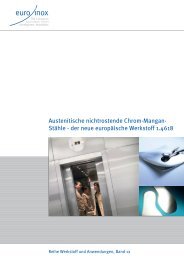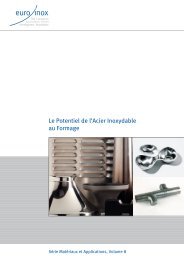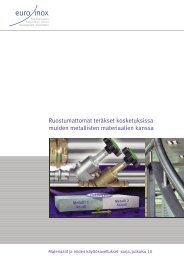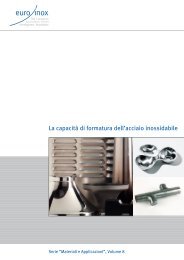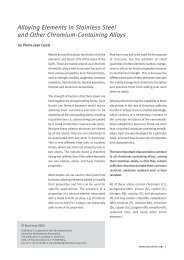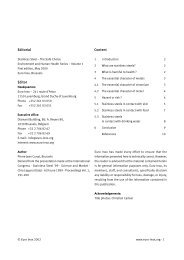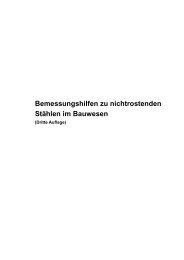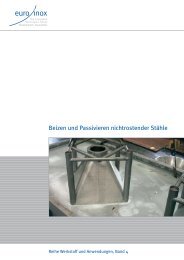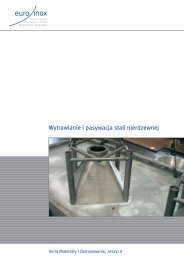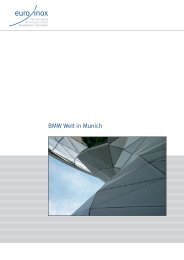Innovative Stainless Steel Applications in transport ... - Euro Inox
Innovative Stainless Steel Applications in transport ... - Euro Inox
Innovative Stainless Steel Applications in transport ... - Euro Inox
Create successful ePaper yourself
Turn your PDF publications into a flip-book with our unique Google optimized e-Paper software.
Apart from the materials <strong>in</strong>cluded <strong>in</strong> the table, some experiments were also carried out<br />
for materials 304SP 2B and 1.4318 <strong>in</strong> C850 and C1000 temper-rolled conditions<br />
(DOLTRAC p. 99). However, because the material thickness (1.0 and 1.2 mm) and<br />
jo<strong>in</strong><strong>in</strong>g methods (arc and laser braz<strong>in</strong>g) were different from the BUS project data, these<br />
results have not been <strong>in</strong>cluded here but <strong>in</strong> a separate table.<br />
Accord<strong>in</strong>g to the results <strong>in</strong> Table 27, practically full base-material strength can be<br />
obta<strong>in</strong>ed with MAG weld<strong>in</strong>g for all the base materials <strong>in</strong> 2B condition. This applies to<br />
both yield strength and tensile strength values. However, it is rather surpris<strong>in</strong>g that the<br />
dom<strong>in</strong>ant failure mode is still <strong>in</strong> the weld metal, the only exception be<strong>in</strong>g the ferritic<br />
1.4003, which shows base-material failure.<br />
The cold rolled higher-strength grades fall beh<strong>in</strong>d the <strong>in</strong>creased base-material strength<br />
levels. The 304 sp and 16-7 Mn still reta<strong>in</strong> approximately 80 % of both base-material<br />
yield strength and tensile strength but the drop is more remarkable for 1.4301: only 40 -<br />
50 % of the base-material level is reached. However, it should be noted that the degree<br />
of strengthen<strong>in</strong>g due to cold form<strong>in</strong>g is much higher for 1.4301, compared to other<br />
alloys. This can be seen particularly <strong>in</strong> yield strength, where cold form<strong>in</strong>g has <strong>in</strong>creased<br />
the base-material strength by a factor of four, whereas for other alloys the strength is<br />
<strong>in</strong>creased by factors of between 2 and 2.5. The difference <strong>in</strong> tensile strength is also<br />
marked: 304SP and 16-7 Mn show a strength ga<strong>in</strong> of 30 - 50 % while with 1.4301<br />
tensile strength has almost doubled. Aga<strong>in</strong>, the most common failure location is the<br />
weld metal or the weld-HAZ <strong>in</strong>terface. Another important feature is that elongation is<br />
lost almost completely <strong>in</strong> the cold-rolled material welds. Some drop (though much less<br />
dramatic) can also be seen <strong>in</strong> the 2B-material results.<br />
The powder plasma arc weld<strong>in</strong>g experiments showed similar behaviour: for the 2B<br />
materials, strength values at or very close to the base-material tensile strengths were<br />
reached, but differences <strong>in</strong> yield strengths were greater. Only tensile strengths were<br />
determ<strong>in</strong>ed <strong>in</strong> these tests, so the yield strengths cannot be compared to the MAG-welded<br />
results.<br />
Laser weld<strong>in</strong>g is commonly regarded as one possible way to avoid the excessive drop <strong>in</strong><br />
strength values that results from the soften<strong>in</strong>g of cold-rolled material. This is because<br />
the small heat <strong>in</strong>put, compared to that of arc weld<strong>in</strong>g, results <strong>in</strong> a much narrower<br />
softened region (i.e. weld metal and HAZ). The effect is most pronounced <strong>in</strong> 304SP and<br />
1.4003 welds. With 1.4301, the effect is less.<br />
90



